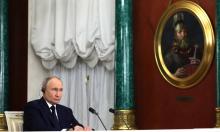The Symbol of Martyrdom for the Faith in Works by S.Eisenstein and S.Prokofiev
In the last years the films "Alexander Nevsky" (1938) and "Ivan the  Terrible" (1942-1946) made by director Sergey Eisenstein and composer Sergey Prokofiev were criticised as deplorable examples of the "atheistic propaganda" and "Stalin's personality cult'. The only excuse for such home-bred criticism of the joint works of Eisenstein and Prokofiev is that its authors only repeat somebody else's thoughts. Obviously, today is a good time to get free from labels and stereotypes, imprinted by the post-Soviet ideology, and to think about the spiritual meaning of the masterpieces of the Russian cinema.
Terrible" (1942-1946) made by director Sergey Eisenstein and composer Sergey Prokofiev were criticised as deplorable examples of the "atheistic propaganda" and "Stalin's personality cult'. The only excuse for such home-bred criticism of the joint works of Eisenstein and Prokofiev is that its authors only repeat somebody else's thoughts. Obviously, today is a good time to get free from labels and stereotypes, imprinted by the post-Soviet ideology, and to think about the spiritual meaning of the masterpieces of the Russian cinema.
Researchers of the Glinka Musical Culture Museum Marina Rakhmanova and Irina Medvedeva conducted a study that contributed a lot to the due appreciation of Eisenstein and Prokofiev's artistic works. Art critics came to the conclusion that an adequate interpretation of the artistic concept of the music to the film "Ivan the Terrible" is impossible without turning to Russian Orthodox singing. Liberation from ideological cliches enabled them to reconstruct the composer's concept. After publishing the score the full version of Prokofiev's music to "Ivan the Terrible" was recorded including a number of compositions performed by the church choir.
During their work on the film about Alexander Nevsky Eisenstein and Prokofiev came across church sources that related about the dramatic struggle of the Russian people with the Teutonic Order aggression in the 13th century. Numerous biblical parallels and associations are typical for the "Life of Alexander Nevsky" and the "Story of Dovmont". For example, from the "Story of Dovmont" the film authors borrowed the comparison of the brothers-crusaders of the Teutonic Order with the soldiers of the Egyptian pharaoh and King Herod, who slew innocent children.
Destroying Russian monasteries, the Teutonic inquisitors burnt monks alive, as well as women and children who sought refuge within the monastery walls. Reference of the regular edition of the "Story of Dovmont" to the barbarities of Catholics in the Pskov suburbs in 1269 is evidenced by documents of the Teutonic Order: "Livonian rhymed chronicle", "Epistle of Master Otto von Lutenberg to the townsmen and merchants of Luebeck 1269" and "Epistle of the Riga city council to the townsmen and merchants of Luebeck 1269" (V.I.Matusova, E.L.Nasarova. Crusaders and Russia. End of the 12th – 1270s. Texts, translations, comments. Moscow, 2002). Stories about Teutonic knights' burning monks, women and children in the Snetogorsky monastery and the Mirozh monastery in 1299 can be found in various copies of the "Story of Dovmont" and almost in all Russian annalistic collections (V.I.Okhotnikova, Story of Dovmont. Study and texts, Leningrad, 1985). The scene from the "Story of Dovmont" "Crusaders in Pskov" symbolizes destruction of the Orthodox shrines by devil’s servants – after refusal to change the faith "the host of godless Chaldeans" put to sword and flames children of God's people.
The image of youths, thrown into fire by enemies of the truth was developed further in the film "Ivan the Terrible". Eisenstein and Prokofiev included ancient Russian "Furnace Play" in the film. The Furnace Play is an ancient Russian liturgical drama which was performed in the Uspensky (Dormition) cathedral in the Moscow Kremlin on the Sunday of the Holy Fathers, a week before Christmas. The story originally comes from the Bible and tells about the miraculous deliverance of three young men who had been cast into a burning fiery furnace by an ungodly king for refusing to worship idols. In ancient time three youths usually sang heirmos stanzas during the mystery play. Archive studies by Doctor of Arts Marina Rakhmanova showed that trying to highlight the most important motives of the plot Eisenstein and Prokofiev created in fact a new text and music for the "Furnace Play". Eisenstein himself wrote the following verses: "We are thrown without guilt for disobedience to the pagan king into the burning fiery furnace, made by the Chaldeans red-hot. Here we are at the mercy of lawless masters, accursed apostates, non-Orthodox king, most evil on earth. Now we have neither a tsar, nor a faithful prince pleasing God to protect the youth, to render God's justice, to curb the proud king. O Lord, we are diminished worse than all peoples and abased on the earth. Why do you, shameless Chaldeans, serve a lawless king? Why do you, demonic Chaldeans, rejoice before a satanic king, a blasphemer, and a torturer? You will see a miracle today: the earthly prince will be abased by the Heavenly Lord. He saves from death, delivers from flames, throws kings down and curbs them."
Both in "Alexander Nevsky" and "Ivan the Terrible" the image of the youth in the fiery furnace contains also a symbol, which is very well known to all Orthodox Christians – martyrdom for the faith. Using this theme in the works of art, created in the situation of persecution against the Russian Orthodox Church, could hardly be introduced only as an illustration for historical plots. Eisenstein and Prokofiev pointed out a spiritual problem that was far beyond the scope of historical events of the 13th and 14th centuries.
Yuri Klitsenko
Subscribe to Pravda.Ru Telegram channel, Facebook, RSS!





